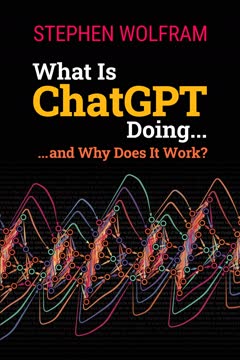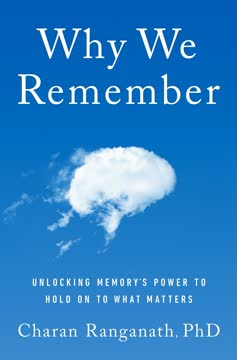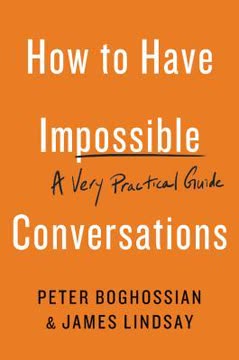Key Takeaways
1. Anxiety sparks signal important beliefs and expectations
Anxiety is a signpost pointing out our personal beliefs and expectations.
Recognize anxiety as information. When we feel anxious during a disagreement, it's a signal that something important to us is being challenged or threatened. This anxiety can range from mild discomfort to intense fear or anger. By paying attention to these sparks of anxiety, we can gain insight into our own values, beliefs, and expectations.
Use anxiety productively. Instead of trying to avoid or suppress anxiety, we can use it as a tool for self-reflection and growth. When anxiety arises:
- Pause and take note of what triggered it
- Ask yourself what belief or expectation is being challenged
- Consider whether this belief is serving you well or needs examination
- Use the insight to guide your response in the conversation
By viewing anxiety as a valuable signal rather than a problem to be eliminated, we can engage more thoughtfully in disagreements and gain a deeper understanding of ourselves and others.
2. Internal voices shape our reactions to disagreements
The voice of possibility gives equal weight to the head, the heart, and the hands, and because it does this without the pressure of being right, the fruits of security, growth, connection, and enjoyment have a chance to take root.
Identify your internal voices. We all have different internal voices that influence how we approach disagreements:
- Voice of power: Seeks to dominate or shut down the conversation
- Voice of reason: Tries to win through logic and facts
- Voice of avoidance: Attempts to escape the conflict
- Voice of possibility: Explores new perspectives and solutions
Cultivate the voice of possibility. This voice allows us to approach disagreements with curiosity and openness, rather than defensiveness or aggression. It balances the needs of the head (logic), heart (emotions), and hands (actions). By strengthening this voice, we can:
- Remain open to new information and ideas
- Seek mutual understanding rather than victory
- Find creative solutions that address multiple perspectives
- Grow and learn from disagreements rather than being diminished by them
3. Acknowledging bias is key to productive conversations
There is no cure for bias, but we can develop an honest relationship to our own bias with self-reflection, frequent requests for thoughtful feedback, and a willingness to address feedback directly, however it comes.
Recognize universal bias. Every human being has biases that shape their perceptions and decisions. These biases are not flaws to be eliminated, but natural cognitive shortcuts that help us navigate a complex world. Key points about bias:
- Biases are unavoidable and serve important functions
- Attempting to eliminate bias entirely is futile and counterproductive
- The goal is to develop "honest bias" – awareness and management of our biases
Develop honest bias. To improve our ability to engage in productive disagreements:
- Regularly reflect on your own biases and blind spots
- Seek feedback from others, especially those with different perspectives
- Be willing to acknowledge and address your biases when they're pointed out
- Use awareness of bias to approach conversations with humility and openness
4. Speaking for yourself avoids harmful speculation
Don't speculate about others, especially groups that you don't belong to. Instead, seek out a respectable member of any group you might otherwise speculate about and invite them to your table to speak for themselves. Listen generously.
Focus on personal experience. When engaging in disagreements, it's crucial to speak from your own perspective and experiences rather than making assumptions about others. This approach:
- Reduces misunderstandings and stereotyping
- Encourages empathy and connection
- Keeps the conversation grounded in real experiences
Invite diverse voices. Instead of speaking for others or entire groups:
- Seek out individuals who can represent different perspectives
- Create opportunities for people to share their own stories and viewpoints
- Listen actively and with genuine curiosity to understand their experiences
By focusing on personal narratives and inviting diverse voices to the conversation, we can build a richer, more nuanced understanding of complex issues and find common ground even in disagreement.
5. Ask questions that invite surprising answers
The bigger the question and the more surprising the potential answers can be, the better.
Craft open-ended questions. The quality of our questions shapes the quality of our conversations. To invite surprising and insightful answers:
- Ask broad, exploratory questions rather than narrow, leading ones
- Focus on "how" and "why" rather than "what" or "when"
- Avoid questions that can be answered with a simple yes or no
Embrace curiosity. Approach disagreements with a genuine desire to learn and understand, rather than to prove a point. This mindset:
- Opens up new avenues of discussion
- Reveals unexpected commonalities and insights
- Builds rapport and trust between disagreeing parties
Examples of powerful, open-ended questions:
- "What experiences led you to this belief?"
- "How might we approach this problem differently?"
- "What would an ideal solution look like to you?"
6. Build arguments collaboratively for mutual understanding
Structure arguments into evidence of the problems and opportunities (to support conflicts of head), diverse perspectives within the argument (to support conflicts of heart), and proposals to address the problems and opportunities (to support conflicts of hand).
Reframe arguments as collaboration. Instead of viewing disagreements as battles to be won, approach them as opportunities for joint problem-solving. This shift in perspective allows for:
- More comprehensive understanding of issues
- Integration of diverse viewpoints
- Creative solutions that address multiple concerns
Use a structured approach. When building arguments collaboratively:
- Clearly define the problem or opportunity
- Gather evidence and data from multiple sources
- Explore diverse perspectives on the issue
- Develop proposals that address various concerns
- Evaluate proposals together, considering potential outcomes and trade-offs
By working together to build a comprehensive understanding of the issue and potential solutions, parties in disagreement can often find common ground and develop more robust, effective approaches to complex problems.
7. Cultivate neutral spaces for open dialogue
A neutral space is inviting; it opens up big questions and allows arguments to strengthen and the fruit of disagreement to grow. It creates wiggle room for perspectives to shift and expand without punishment or shame.
Create safe environments. Productive disagreements require spaces where people feel safe to express their views and explore new ideas without fear of judgment or retaliation. Characteristics of neutral spaces:
- Open to diverse perspectives
- Free from power dynamics that silence certain voices
- Encourage questioning and exploration
- Allow for uncertainty and changing opinions
Foster a culture of dialogue. To cultivate neutral spaces:
- Establish ground rules for respectful communication
- Encourage active listening and curiosity
- Celebrate the sharing of different viewpoints
- Provide opportunities for informal, low-stakes conversations
- Model openness to new ideas and willingness to change your mind
By creating environments that welcome diverse perspectives and encourage open exploration of ideas, we can tap into the full potential of disagreement as a tool for growth, innovation, and mutual understanding.
8. Accept reality, then participate to create change
We can't change reality from the realm of wishful thinking and willful blindness. We can't hide from dangerous ideas. We're right in the mess with all of it, getting our heads, hearts, and hands dirty. The only way out is through.
Embrace complexity and uncertainty. Real-world problems are often messy, complicated, and resistant to simple solutions. To engage productively:
- Acknowledge the complexity of issues rather than oversimplifying
- Be willing to sit with uncertainty and discomfort
- Recognize that perfect solutions are rarely possible
Take action despite imperfection. Once we've accepted the reality of a situation:
- Identify areas where you can make a positive impact
- Start with small, achievable steps
- Be willing to experiment and learn from failures
- Collaborate with others to amplify your efforts
By accepting reality as it is, rather than as we wish it to be, we can move beyond wishful thinking and engage meaningfully with the challenges we face. This approach allows us to:
- Make progress on difficult issues
- Learn and adapt as we go
- Build coalitions for change
- Find unexpected opportunities for improvement
The path forward often involves getting our hands dirty, making mistakes, and continuously adjusting our approach. By embracing this messy process, we can create real change and grow both individually and collectively.
Last updated:
FAQ
1. What is Why Are We Yelling?: The Art of Productive Disagreement by Buster Benson about?
- Transforming conflict: The book explores how to turn arguments and disagreements from destructive conflicts into productive conversations that foster growth, connection, and understanding.
- Mindset shift: It challenges the idea that arguments are battles to be won or avoided, instead presenting them as opportunities for learning and collaboration.
- Practical framework: Benson introduces practical strategies and frameworks, such as the “realms of disagreement” and “internal voices,” to help readers engage more constructively in disagreements.
2. Why should I read Why Are We Yelling? by Buster Benson?
- Everyday relevance: Disagreements are inevitable in all relationships, and most people lack the skills to handle them productively; this book offers tools to reduce frustration and anxiety around conflict.
- Skill development: Learning the art of productive disagreement can improve communication, relationships, and collaboration in both personal and professional life.
- Broader impact: Benson argues that productive disagreement is a “superpower” that enhances friendships, family life, work, and even citizenship by turning conflict into opportunities for connection and growth.
3. What are the key takeaways from Why Are We Yelling? by Buster Benson?
- Productive disagreement as a metaskill: The ability to engage in disagreements constructively is essential for personal and social success.
- Internal voices and biases: Recognizing and managing internal voices and cognitive biases is crucial for navigating conflict.
- Practical habits: The book offers actionable steps, such as asking better questions, building arguments collaboratively, and creating neutral spaces for dialogue.
- Fruits of disagreement: When handled well, disagreements can yield security, growth, connection, and enjoyment.
4. What are the most important quotes from Why Are We Yelling? by Buster Benson and what do they mean?
- “Arguments are like weeds in a garden.” This metaphor suggests that disagreements, though often unwanted, are natural and can enrich relationships if managed well.
- “The only mind you can reliably change is your own.” Benson emphasizes focusing on understanding and collaboration rather than trying to win or change others.
- “Productive disagreement is a superpower.” Mastering this skill can multiply positive outcomes across all areas of life.
- “Embrace aporia—the enjoyable recognition of not knowing or being wrong.” This quote highlights the value of curiosity and openness in disagreements.
5. What are the three main misconceptions about arguments according to Why Are We Yelling? by Buster Benson?
- Arguments are bad: Arguments are not inherently negative; they become unproductive due to lack of skill and understanding.
- Arguments change minds: Trying to change others’ minds often backfires; productive disagreement is about bringing minds together, not winning.
- Arguments end: Disagreements have deep roots and tend to resurface; they require ongoing engagement and care, much like tending a garden.
6. What are the “realms of disagreement” in Why Are We Yelling? and why are they important?
- Head realm (What is true?): Disagreements about facts and objective truth, often resolvable with evidence.
- Heart realm (What is meaningful?): Disagreements about values and personal meaning, requiring empathy and respect for subjectivity.
- Hands realm (What is useful?): Disagreements about practical actions and strategies, best addressed through compromise and experimentation.
- Tailored approach: Recognizing the realm helps choose the most effective strategy for resolution.
7. What are the “four internal voices” described in Why Are We Yelling? by Buster Benson and how do they influence disagreements?
- Voice of Power: Seeks control or dominance, often leading to resentment and polarization.
- Voice of Reason: Relies on logic and shared rules, effective within similar groups but limited across diverse perspectives.
- Voice of Avoidance: Avoids conflict, allowing issues to fester and grow.
- Voice of Possibility: Embraces conflict as an opportunity for exploration, learning, and collaboration, leading to more creative and productive outcomes.
8. What is “honest bias” in Buster Benson’s method from Why Are We Yelling? and how can it help in disagreements?
- Acceptance of bias: Recognizes that cognitive biases are unavoidable mental shortcuts that help us manage complexity.
- Four-step path: Opt-in to recognizing bias, observe blind spots, repair damage, and normalize seeking diverse perspectives.
- Growth through discomfort: Embracing discomfort signals growth and helps reduce harm from unconscious biases.
- Continuous improvement: Honest bias is about ongoing self-awareness and openness to being wrong.
9. What are the “four fruits of disagreement” in Why Are We Yelling? and why are they important?
- Security: The default goal, focusing on safety and self-worth, but can lead to defensive, zero-sum conflicts if overemphasized.
- Growth: Involves learning and gaining new insights, requiring openness and risk-taking.
- Connection: Builds trust and strengthens relationships through honest and empathetic dialogue.
- Enjoyment: Adds motivation and fulfillment, making the process of disagreement more engaging and less stressful.
10. How does Buster Benson recommend asking questions that invite surprising answers in Why Are We Yelling??
- Open-ended questions: Use questions that encourage detailed stories and personal experiences rather than yes-or-no answers.
- Purposeful curiosity: Good questions help map another person’s perspective, increasing understanding and empathy.
- Trust and safety: Ensure that answers won’t be weaponized, fostering honest and open sharing.
- Examples: Questions like “What experiences have led you to your current beliefs?” open up richer dialogue.
11. What does “building arguments together” mean in Why Are We Yelling? by Buster Benson?
- Collaborative reasoning: Instead of competing to win, work together to strengthen all sides’ arguments and find better solutions.
- Problem briefs vs. essays: Use collaborative problem briefs that collect multiple proposals and criticisms, rather than single-thesis essays.
- Anticipating flaws: Employ exercises like the “monkey’s paw” to anticipate and address potential unintended consequences.
- Richer understanding: This approach leads to more robust, nuanced, and creative outcomes.
12. What are the key guidelines for productive disagreements in Why Are We Yelling? by Buster Benson?
- Eight practical steps: Watch anxiety sparks, talk to internal voices, develop honest bias, speak for yourself, ask surprising questions, build arguments together, cultivate neutral spaces, and accept reality before participating.
- Holistic approach: Integrates cognitive, emotional, and social strategies for more effective disagreements.
- Focus on growth: The goal is not to avoid conflict but to transform it into a creative and constructive force.
- Ultimate outcomes: Productive disagreements yield security, growth, connection, and enjoyment, benefiting all parties involved.
Review Summary
Why Are We Yelling? receives mixed reviews, with an average rating of 3.61 out of 5. Readers appreciate the book's insights on productive disagreement, cognitive biases, and communication strategies. Many find the first half more engaging, praising the author's clear writing style and thought-provoking ideas. However, some criticize the book for being too focused on organizational and societal aspects rather than interpersonal conflict. Critics also note that the practical advice in the latter half falls short and that the author's political views occasionally interfere with the message.
Similar Books










Download PDF
Download EPUB
.epub digital book format is ideal for reading ebooks on phones, tablets, and e-readers.




